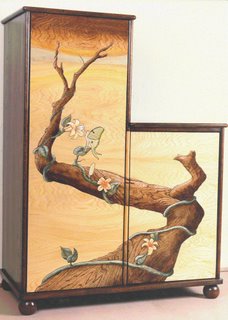By: Narelle Davison
The internet has an endless number of benefits for craftspeople, not just as a medium for selling the end product but for each step that leads to sales. The fact that you are reading this shows that you already utilise the web for information but perhaps you have not yet considered some of the following points presented.
The ideas provided in this article have come from interviews with craftspeople, conducted for AussieCrafts.com, in the interest of sharing information with our peers. When boiled down to its bare essentials this is the true essence of the internet but it sometimes gets lost in all of the advertising and sales. The interviews spawned a host of ways in which the internet assists the crafters, both in their business and creatively, and provided much insight into untangling the web.
Inspiration:
When asked about the sources they use for inspiration most craftspeople have said that the internet is a much used research tool. This is particularly useful with commission pieces, where a client gives a basic idea and there is a need to familiarise yourself with the subject. Browsing websites is also great for when you want to start a new piece but are not quite sure where to begin. No matter what craft you do if you are stuck for ideas on what to create there are always plenty of places to get some quick inspiration online. The obvious way to get ideas is to search for your craft in the search engines but some other methods are:
Type your craft name into Google image search
Yahoo groups on your craft often have galleries
Online stores that sell your craft
Craft directories
Historical sites related to your craft, most crafts did after all come from very ancient beginnings.
Try searching for crafts that are similar to yours, if you do pottery, for example, search for glasswork. The colours and shapes are likely to spark new ideas.
If it’s a more abstract inspiration that you need such as colour or texture then art, photography and nature sites are fantastic sources of ideas. Stock photography sites (such as www.dreamstime.com), for example, have thousands of images of almost everything imaginable. Let’s say you want to create a bead necklace that reflects the colour and movement of the ocean. If you browse the sea and ocean category of a stock photography site you can jot down ideas based on what you see as you view page after page of photographs that cover every aspect of the ocean.
Education: patterns and tutorials
There are very few crafters who believe they know everything there is about their craft. Who of us do not want to learn something new? The internet is the best source of tips, tricks, patterns and tutorials on every craft imaginable, so much so that many craftspeople no longer purchase books about their craft. Many sites offer this information for free, as a way to attract and keep surfers, much the same way as articles like this are utilised. Others charge a subscription or a cost per tutorial, often downloaded as an e-book or a pdf file. For many crafts there are also online classes or lessons via email, again some are free (and often include advertising) and others are subscription based.
To find these valuable resources consider using some of the following terms alongside your craft name: tutorial, pattern, learn to, ebook, lesson, techniques, instructions or projects. These keywords were tested using Google search and beading, for example ‘beading projects’, and the results were astonishing. If it a particular technique you are searching for then add that to your search query, for example ‘beading peyote technique’, where peyote is a type of beading stitch.
Purchasing tools and materialsThe internet has brought about a convenient way to buy almost anything, from anywhere in the world, and to craftspeople this has been one the most important benefits of being online. Often there are supplies needed for craftwork that are not available locally and this can be the case no matter where you live. It may be because it is only manufactured in a small area of Europe or that there are few people working in the same craft as you and therefore there is little demand.
Apart from availability issues nothing is better than being able to browse many stores in a short space of time and not only get prices but also see things without having to leave home. Ebay is popular with many craftspeople due to the range of goods and their prices, you can find both new and secondhand tools and materials there. Shopping online means more time for doing what you enjoy or what brings in your income. The world is becoming smaller and shipping costs and delivery times are too.
Often the websites that sell crafts materials also have a range of useful resources such as guides to using their products. They also have convenient contact information, like email, and as they are often craftspeople themselves can give advice on craft specific problems.
Publicity and exhibition requests
Many of the sources that are traditionally used for publicity such as magazines, newspapers and event organizers are now using the internet as a way to find craftspeople. Not only is the internet often a faster way to find what they need but it is also a visual medium. Therefore having a website for your craft business is not just about gaining sales and commissions but it also provides a way for the media and galleries to see your work.
One example of this is an artist interviewed on Aussie Crafts who has in the last few months been contacted by a lifestyle magazine to do an article on her work, as well as another contact to request her involvement in an exhibition. Both of these publicity avenues have stemmed from her website, which contain galleries of her work.
This same artist is also a member of an organisation supporting her medium, which has a website that lists galleries showing members’ works at any given time. There are organisations such as this for many crafts, both global and local, that are worth having a membership with.
Sales and commissions:
The most obvious way that craftspeople are using the internet is to sell their products to a wider market than previously possible, what is not so obvious is that there are many ways to do this. One artist interviewed extolled the virtues of the internet as, "It's been huge for us. We sell artwork and DIY kits all over the world and so put virtually all our marketing energy into our website. We get well over five thousand visitors every month at basically no cost and the whole world has become our target market."
Some of the reasons people decided to sell their crafts online include not having to deal with galleries, no commissions to pay, less overheads than a store and the fact that there is more time crafting and less selling.
Apart from setting up an often expensive e-commerce website there are other means to gaining online sales:
A 'brochure' style site, which displays the products you make but does not sell them online. Instead it can be used to promote a market stall, shop front, commission enquiries etc.
Many craftspeople are selling their work in auctions at Ebay; this can be a lucrative option for the right products.
Online craft malls are a way to have an online presence without the hassle and overheads of building an e-commerce site. Search for craft malls in the search engines and you will find such sites as craftmall.com, aokcorral.com and lilysplace.com. These sites generally use Paypal as a payment option to take the headaches out of online payments and are similar to Ebay without being auction based.
Human contact:
One of the common problems that people who craft for an income mention is loneliness. Oftentimes they work at home alone and this can be very isolating. The internet can provide avenues to have contact with others who craft. They could be in the same locality as you and allow for face-to-face meeting or they may be on the other side of the world.
There are many group and organisations for most craft genres, such as Yahoo groups or MSN chats. Often if it is a location-based group there are classes and retreats organised for people to come together and learn. These groups can become invaluable for technical advice, feedback and learning but also that human contact that is a necessary part of life.
Client contactEmail is a fantastic way to keep in touch with clients and industry contacts. It is so much cheaper than a phone call (i.e. free) and is much less time consuming. Email provides a simple means to show clients’ examples or progress on a work via photograph attachments. It also provides a record of all communication.
Online messaging systems, available for free from MSN and Yahoo, are also useful ways to keep in contact with customers. These can even be used to give online support by providing your identification name on your website. However these systems can become a time waster instead of saver if you are not careful.
Narelle Davison comes from a craft background but changed careers to marketing and web development. She has created the Australian arts and craft site, Aussie Crafts, to provide information and promotion for craftspeople through interviews, articles, forum and directory. The interviews provide great reading to both admirers of each craft and fellow crafters. If you are an Australian craftsperson and would like to be interviewed please visit http://www.aussiecrafts.com/interviews.html . This article can be republished if the byline links are kept intact.
Article Source: http://EzineArticles.com/?expert=Narelle_Davison
Read more!








